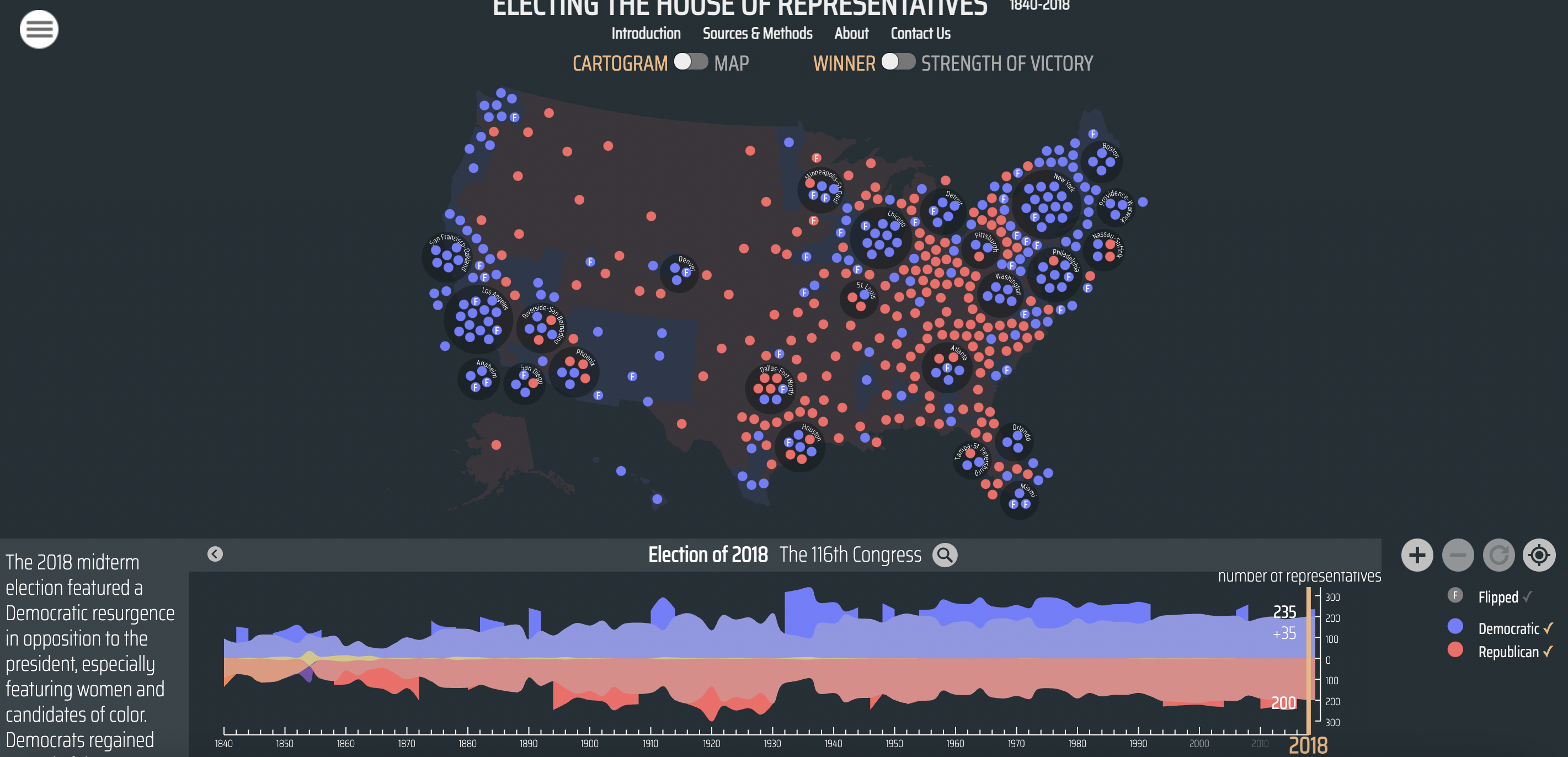Electing the House of Representatives
Combining good old-fashioned archival research with new digital cartographic and visualisation tools, Electing the House of Representatives bring to life how the United States has voted for members of the lower house of Congress. Transforming electoral data into a clearer and more accessible form, it is a nifty means of demonstrating democracy in action and provides an interesting visual record of how patterns of American voting have changed (or not in some instances) over time. Like The Executive Abroad, the website is part of the American Panorama project, which is described by its creators as a historical atlas of the United States.
Electing the House of Representatives consists of two primary components, a map of the United States and a graph highlighting the number of Democratic and Republican representatives elected from 1840 to 2018, as well as pop-ups providing further information entitled ‘Introduction’, ‘Sources & Methods’, ‘About’, and ‘Contact Us’. In ‘Introduction’, visitors are given a comprehensive overview of not just the project but also of the United States Congress and particularly the House of Representatives. Moreover, the pop-up also provides a brief but enlightening discussion of how reapportionment, redistricting, and gerrymandering fit into Congressional History. ‘Sources’ provides a peek behind the curtain on the data that was used to create the map and graph as well as the methodology behind how said data was interpreted and visualised. The ‘About’ section gives credit where credit is due, listing the institutions and people involved in building the platform as well as providing a handy guide for how to cite it in Chicago style referencing. Meanwhile, ‘Contact Us’ features a basic contact form where visitors can get in touch with the developers if they were so inclined.
As outlined above, the key focus of the platform are the map and the graph. The map has a series of settings that can be changed with sliders provided to switch views of electoral patterns in the form of a cartogram or map and the first instance and in terms of whether the elected party is visualised as a winner or on the basis of their strength of victory. Republican and Democrat seats are of course rendered in the classic red and blue respectively with an ‘F’ also provided to represent seats that were ‘flipped’ during the selected election. Visitors can also zoom in and out to get a better sense of a specific state or of the United States as a whole and there is also a handy button for the website to detect your location and bring you the specific district you belong to. Clicking on specific points on the map brings up relevant information about the representative elected to the seat and changes the graph to feature how voting patterns in the district has changed over time. The graph itself operates on a sliding scale with users selecting which election they would like to learn more about by sliding back and forth across the timeline. Selecting the different datum points results in a corresponding change on the map to reflect the electoral contests in that particular year but also provides a brief overview of the election to the left of the chart.
In the first instance, Electing the House of Representatives is a convenient and well-rendered archive of Congressional electoral history from 1840 to 2018. The platform can be used in two other major ways in a classroom setting, with a focus either on depth or breadth. In the case of the former, teachers can task students into picking a particular election year and consult secondary sources in order to developed a more detailed understanding of political dynamics at the time and what prompted an incumbent victory or for particular seats to flip or for the balance of power to shift from one party to another. For an activity focussed on breadth, students can be instructed to trace changing voting patterns over time and work with Census data and other primary sources to analyse how and why Congressional representation has changed (or not) over time on a whole or in specific contexts.
A stunning visual representation of the political history of the House of Representatives in the United States Congress, Electing the House of Representatives is an important digital tool well-placed to teach students and the public about the function of the legislative body and the exercise of the franchise in the United States over a century and a half.
